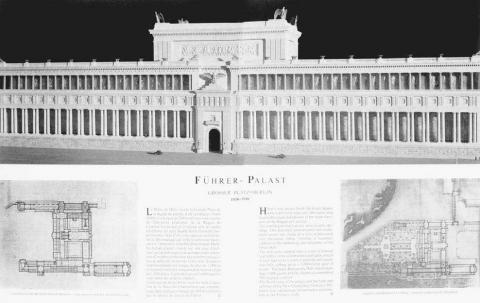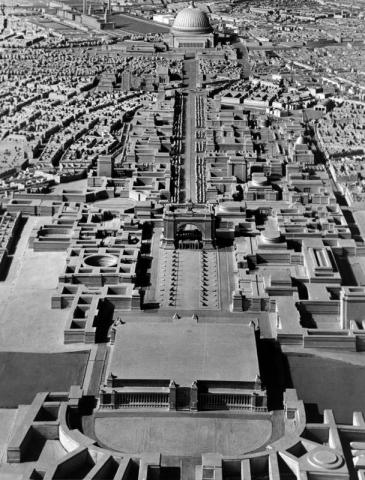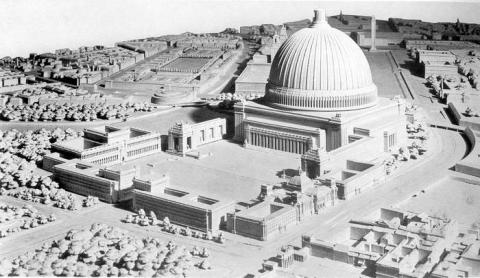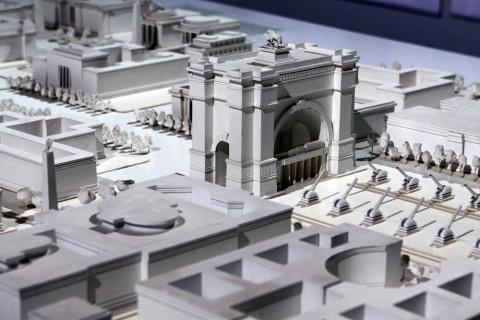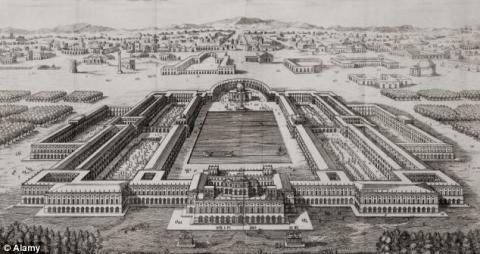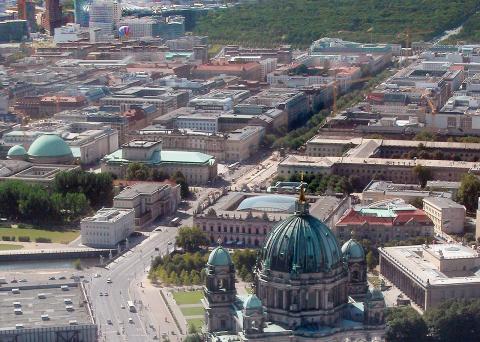The Battle of the Architects
- 2732 reads
Giesler on Speer: The Battle of the Architects
- 18594 reads
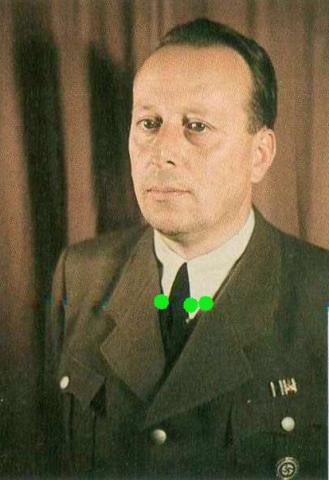
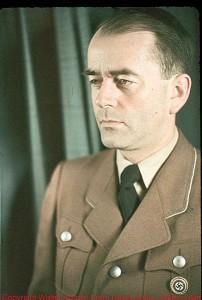
Hermann Giesler on left; Albert Speer on right, both in their NSDAP uniform and wearing the Golden Party Badge.
In his memoir about the Adolf Hitler he knew (Ein Anderer Hitler), Hermann Giesler devoted a section to his difficult relationship with architect Albert Speer. Divided into six parts, it covers 42 pages, from pg. 318 to 360. Wilhelm Kriessmann translated the entire section in 201l, but we decided not to include it as part of our series from Ein Anderer Hitler, but to publish it separately. However, Willis Carto never decided to buy the right to publish it in The Barnes Review, as he did the others, even after we condensed only selected parts of it.
Thus it is that now, several years later, I am finally getting back to this project and putting what I consider the most relevant parts of Giesler's commentary on Speer into shape for publication on my website. I will first post these parts separately in the blog, and then archive them under Ein Anderer Hitler on the sidebar.
I begin, not at the beginning, but with Giesler's third entry which was titled “The Flight to Posen.” I think it's a good introduction to the character of Albert Speer, the relationship between the two men, and how Speer was generally viewed amongst some of the others of the inner circle around the Führer. Not without respect, of course, because it was plain to everyone that the Führer valued him highly. But the thread running throughout Giesler's writing on the subject of Speer is to make known the hypocrisy, to the point of duplicitousness, contained in Speer's descriptions of Hitler during the IMT “trials” at Nuremberg and in his later memoir Erinnerungen [Reminiscences] published in 1969 [1970 English language version titled Inside the Third Reich]. The same was true in Speer's second book, Spandauer Tagebuecher [Spandau Diaries] (published in English in 1976 as Spandau: The Secret Diaries. -Carolyn Yeager

Adolf Hitler's personal Fw 200 Condor, bearing the insignia of the Fliegerstaffel des Führers on its nose.
The Flight to Posen
Taken from Hermann Giesler's memoir Ein Anderer Hitler
Translated by Wilhelm Kriessmann and Carolyn Yeager
copyright Carolyn Yeager 2014
“I just caused Doenitz's anger when I told him during the walk in the garden about Hitler's trip to Posen towards the end of 1939, with a 4-engine airplane, to pick up Christmas geese. Bauer, Hitler's pilot, argued the rarely used aircraft needed some practice flights. The geese were for parcels Hitler sent at Christmas to friends and acquaintances. This was for Doenitz a rather strange mix of middle class and potentate, however incorrect it was. He was upset and finally found a way to not believe my story.” -Speer
The Grand Admiral was right and reacted properly. If Speer uses the flight to Posen with a four-engine aircraft as an example of Adolf Hitler's middle-class benevolence1 combined with a monarchical sense of privilege, then I feel responsible to describe the flight to Posen truthfully, as it really happened.
On the evening before the flight we talked at the Reichs Chancellery about city building and architecture. At the end, Adolf Hitler spoke about theater buildings, architects and regents like Wilhelm II who supported the construction of the theater in Posen. “The condition of Posen and its theater would interest me very much,” said Hitler to Speer and me. “Captain Bauer can fly both of you to Posen. In the evening I'd like to receive your report.”
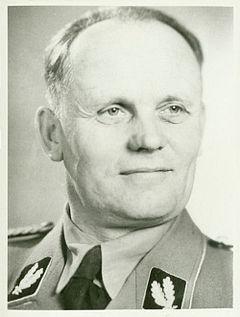
Next morning, it was captain Bauer (pictured right), his co-pilot Beetz, an army adjutant, Speer, myself and, as an additional flight guest, also Kannenberg, the household manager of the chancellery. At once 'suspicion' and also the question arose: Maybe Mr. Kannenberg wants to do some hoard-shopping? A gentle smile was the only answer. I had met the rotund Kannenberg on many occasions. He had the well-cushioned face of a gourmand, with quick button eyes, apparently good-natured like most of the well-nourished.
We relaxed in the Fuehrer cabin. I did not pay any attention to what Speer discussed with Bauer before we took off. We flew very high with clear visibility. Speer got up, nonchalantly said, “Now I will take over the steering and do the piloting,” and disappeared into the cockpit. Bauer appeared in the cabin, “The Speer wants to fly, well, he can show us now what he is able to do!”
He showed it—or better the copilot showed his art and how the aircraft reacted. Up till now Kannenberg had only raised his eyebrows and looked timidly with his button eyes to the captain. Now he started to yell because the airplane turned, first rocking, then diving with a full throttle. Kannenberg was lifted out of his seat, floating, his arms and legs helplessly swinging as if they were not his. Coming out of the dive, the aircraft pulled up to a sudden half looping, then swept down over the wing. Kannenberg fell to the floor and moaned. Bauer was holding on to the handles. “The Speer can't ...” I heard him say as he returned hand over hand to the cockpit.
I kept my legs anchored under the seat, holding with my hands the belt which I could no longer fasten. I knew now what was happening and the grotesque quality of it forced me to laugh, but that was gone fast. I clenched my teeth so that my stomach would not … well, now Kannenberg was sliding towards me at an angled position, then he was flying into the other direction … what a tangle!
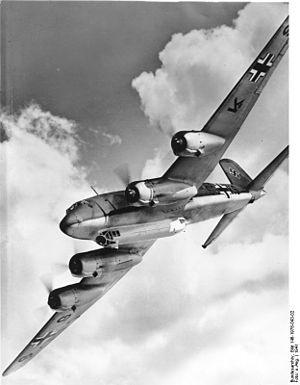
Finally the airplane straightened out and the adjutant and I took care of Kannenberg. We straightened him up and fastened his belts. He was pale with blue lips. Then Speer appeared with a grin like Ruehmann's teenager Pfeiffer (from a movie Quax der Bruchpilot). I pointed toward Kannenberg and the grin disappeared. It was lucky we landed soon in Posen. Kannenberg gasped as they put him on a stretcher and wrapped him in blankets, a doctor taking care of him.
If Kannenberg flew with us in order to hoard or look out for Christmas geese and adequate connections—that ís possible, but that's all—then everything remains of the accident in the cabin because he was now completely done in. But I cannot imagine that, as Speer writes, geese should have been transported in the Führer's airplane. Curious eyes were all around, there was already enough attention just because of the aircraft, besides Kannenberg laying on the stretcher. One needed only to add the remark: Look, the Führer's aircraft is being loaded with geese!
Speer and I drove from the airport to town to pursue our task to find out what is going on in Posen, and to have a proper visit of the theatre. We spent almost 5 hours. Well! - then the Christmas geese could have been loaded in the meantime into the freight compartments of the aircraft ?
I wrote to captain Bauer: “You must know very well if the airplane piloted by you transported geese.” He answered right away: “Naturally I remember that flight when I flew both of you to Posen and what happened to Kannenberg, who was then out of circulation. However, to pick up some geese for the Führer, that is an invention of Speer. That Kannenberg might have intended to look for geese was his own business, but I am not even sure about that. I do not know anything about it. The Führer had no interest at all, as we know. This is once more a machination typical of Speer in order to smear the Führer and us.” Only that far will I quote captain Bauer's letter about the flight to Posen.
In the late evening, I reported my impression of Posen and the run-down theater. Adolf Hitler said to me, “Now tell me how the flight was. I am informed but I wanted to listen to you too. Mrs. Kannenberg told me her husband is in bad shape. Now, what happened?”
I did tell the story my way and noticed that he could not hide a slight smile. As I then described the part of Kannenberg on the stretcher covered in blankets and taken care by a doctor, Adolf Hitler turned serious. He said, “The fun could have ended badly. I have to admonish you seriously, I owe it to Mrs. Kannenberg, she runs my household. I ask you to consider that in the future.”
Finally, it should be said here for good: There has been no “other flight to Posen” by Hitler's 4-engine aircraft.
Speer had often a Heidelberger joke and prank in mind! It started with a “special good Havana” he offered which exploded when you began smoking. He continued by “sending you into April” then by giving “friendly hints.” All that might still have been acceptable, but often it ended with bad insinuations, bordering on maliciousness.
The geese-transport of Posen with the 4-motor Fuehrer aircraft was a case irritating the Grossadmiral's mind. It is part of Speer's “richness of thoughts and sincerity,” in keeping with Zuckmeyer's2 breathtaking remark: Concerning Speer personally, he is of an arrogant sensitivity.
End Notes:
1. This is considered a put-down by Speer, whenever he referred to Hitler or Giesler as "bourgeois."
2. Carl Zuckmeyer, a German-Jewish playwright. His plays were prohibited in Germany after 1933 (Zuckmayer's maternal grandfather had been born Jewish and converted to Protestantism). Zuckmayer and his family moved to their house in Austria, where he published a few more works. After the Anschluss he was expatriated by the government, and the Zuckmayers moved to the United States in 1939, where he first worked as a script writer in Hollywood. In 1943/44 he wrote "character portraits" of actors, writers and other artists in Germany for the Office of Strategic Services (OSS), evaluating their involvement with the Nazi regime. This became known only in 2002, when the approximately 150 reports were published in Germany under the title Geheimreport.
Tags
architectsCategory
Adolf Hitler, Germany, National SocialismBattle of the Architects, Part 2
- 7475 reads


Hermann Giesler on left; Albert Speer on right,
The Contradictious Speer
From Hermann Giesler’s memoir Ein Anderer Hitler
Der zwiespältige Speer, pages 332-339
1977 edition, Druffel-Verlag
Translated by Wilhelm Kriessmann and Carolyn Yeager
copyright Carolyn Yeager 2014
This section from Giesler's memoir Ein Anderer Hitler deals with his correction of Albert Speer’s insulting statements about the Fuehrer at occasions when Giesler was present or knew differently because of his own experience with Hitler.
To add some perspective to Giesler’s account, we remind you that Speer’s biographer Gitta Sereny titled her book, Albert Speer: His Battle With Truth.
In addition, Nicolaus von Below, Hitler’s Luftwaffe adjutant from 1937-45, wrote in his memoir At Hitler’s Side about an incident of seeing a striking red color appear in the sky while in the company of Hitler on the terrace at Obersaltzberg in Aug. 1939. He told Hitler it augured a “bloody war.” He said he “recounted this conversation to Speer in 1967 but later he (Speer) attributed my remark erroneously to Hitler in his book Erinnerungen.”1
Similarly, Christa Schroeder, one of Hitler’s secretaries, when describing Hitler’s walks around Berchtesgaten and a particular rocky promontory with a guard rail that offered an outstanding view, wrote: “Speer is mistaken when he says that Hitler had no feeling for the beauty of the landscape. Hitler would always wait at this promontory for his guests to catch up and then all would enjoy the view together.”2
But these are nothing compared to what Hermann Giesler has to say. The following is found under the heading “Der zwiespältige Speer” in Giesler’s Ein Anderer Hitler. It begins with city visits the three of them made together for the purpose of furthering their architectural and city planning ideas.
* * *
When he wrote about Hitler’s views on architecture [in his first book Erinnerungen (Reminiscences)] , Speer preferred to use Adolf Hitler’s visits to the cities of Paris, Augsburg and Linz to degrade Hitler with malicious remarks and arbitrary insinuations without recognizing how much he degrades his own credibility thereby.
When describing Adolf Hitler’s trip through Paris with the two architects and the sculptor he regarded most highly (Speer, Giesler and Arno Breker), Speer uses incorrect data. Speer could not describe that city visit in a more hateful way than by his closing remark: “The final destination of our trip was the romantic, sweet imitation of early-medieval cupola churches, the Sacre Coeur church at the Montmartre, a surprising selection even for Hitler’s given taste.”
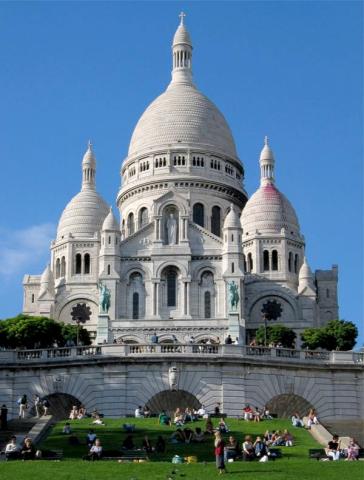
Basillica of Sacre-Coeur at the summit of butte Montmartre was NOT admired by Adolf Hitler, but was visited because it was the highest point in Paris from which to view the city plan.
To put Sacre Coeur, which fits so well in the picturesque world of Utrillo,3 into Hitler’s architectural world is not only an insinuation but an intentional infamy. Because Speer knew very well that the last stop of our Paris trip was not Sacre Coeur, but the panoramic view from the Sacre Coeur of the city’s architectural layout.
The same resentment can be noticed when Speer gives his opinion about Hitler and the city renewal of Augsburg. He uses much space for it and takes a chance to include in his remarks the “intriguing” Martin Bormann and, further on, also me. There you can read: “Hitler found in Hermann Giesler an architect who conceived and precisely executed his intentions. The first design of the Augsburg forum, however, was too similar to the planned Weimar project, also by Giesler. When Hitler criticized it, Giesler put a baroque crown on top and Hitler became enthusiastic."
Indeed, that simple it was! My designs of the Augsburg forum never showed even the least similarity to the Weimar forum, although they did, at their first stage, not yet comply with Hitler’s idea of the Augsburgian city character which he wanted to be integrated into the new part of the city. After my first design, the Augsburg Tower was never changed. Speer writes further “That project was financed by postponing apartment buildings.” But it was not financed at all and never built.
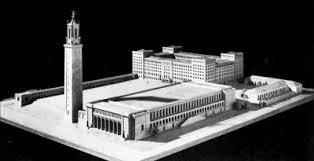
Model for the Augsburg Forum and Tower, designed by Geisler, that was never built.
WHO’S TO BE BURIED IN LINZ?
Speer’s description of the Linz city visit also needs explanation. Speer combines two visits of Adolf Hitler, September 1940 and spring 1943, into one. And he again talks it down and manipulates it. Is he not aware that he cannot recklessly spin his yarn? Did he stay to Hitler’s right side and I to his left or the other way around?4 Speer turns our visit to the Nibelungen bridge with the Siegfried and Kriemhild sculptures into a disgraceful tirade. Adolf Hitler had suggested to me that in judging those sculptures one should not see them as free sculptures but as decorative symbols of the bridge and its name. Maybe, he added, the base of the sculptures should not show a relief but a mosaic—to emphasize its decorative meaning.
Niebelungen Bridge in Linz that Hitler rebuilt, as it stands today. Notice the tall sculpture that Hitler refers to at the entrance to the bridge.
Speer then started with the nonsense about Hitler’s gravesite. “High above the city at the upper tower level,” he pontificates in a quasi-pre-Raphaelian5 mood, and adds, "I think it was that afternoon when Hitler, carried away by his own enthusiasm, declared for the first time that his sarcophagus should be placed at the ‘future symbol of Linz,’ the highest tower of Austria." Adolf Hitler never said anything like that. From the time I got the job for the renewal of Linz, in autumn 1940, his directive was, “Preserve the grave of my parents in a small crypt in the lower tower floor.”
Still, Speer’s version of Hitler’s tower-gravesite instigated [historian] Joachim Fest 6 to try to document it thus: "He saw his gravesite in a gigantic crypt in the clock tower of the huge building he planned at Linz, above the bank of the Danube." Fest's notes sourced this as:
“Speer’s personal information. However, one of Hitler’s other favored architects, Hermann Giesler, denies that Hitler wanted to be buried at the clock tower of the building above the bank of the Danube at Linz; only Hitler’s mother would be buried there. Speer, though, remembers definitely Hitler’s remarks that he wished to be buried exactly at that place in Linz."7
That “gigantic crypt in the clock tower" was, in my plans, an octagon room with a diameter of about four meters by five meters high, including the vault. And that vaulted crypt was to be the resting place of Hitler’s parents. It’s all nonsense, even though Fest quotes Speer’s yarn-spinning. But is it that important? Regarding the gravesite itself, not really; but rather in connection with Hitler’s idea to combine his gravesite with the Hall of The Party in Munich. This fascinating connection was the basis of my designs and trial models in autumn 1940, and also the topic of many talks after the city visit of spring 1943.
INDUSTRY, TRAFFIC AND AUTOBAHN
Speer then describes the visit to the Linz steel plants, today the VOEST steel factory, internationally well known. He again describes in a few sentences ‘Hitler’s world of architecture’:
“When we left the large steel hall, Hitler once again expressed understanding for the modern architecture of steel and glass: ‘Look at the tremendous length of this hall over 300 meters long. How beautiful are the proportions! Here we face different requirements than at the party forum. There our Doric style expresses the new order, here the technical solution is the proper way. If one of those supposedly modern architects tells me he wants to build living quarters and city halls in that style, then I say: He has no idea. That is not modern, it is tasteless, and also violates the eternal laws of the art of building. The workplace needs light, air and usefulness; of a city hall I request dignity, and from an apartment house I demand security which helps me to endure the daily struggle. Speer, imagine a Christmas tree in front of a glass wall. Impossible! As everywhere, we have to consider life’s variety.’”
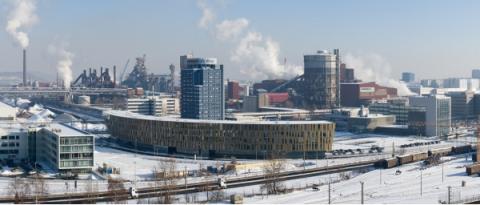
The VOEST-Alpine complex in Linz, Austria
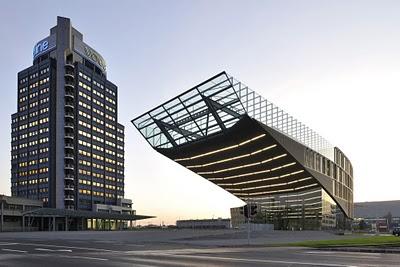
Modern glass and steel building at Voest-Alpine today houses the financial and commercial departments.
Speer describes by this short rendition what Adolf Hitler said about natural diversity and its consequent distinctions for the design of buildings. Clumsy, and in piecemeal fashion, Speer’s description of Adolf Hitler’s remarks lost the color and strength that, after all, so eminently signified Hitler’s ideas. His thoughts about the necessary security at your home, about the form housing projects should have, about the rationale of a glass wall conveying the hard, sober world of labor compared to the world of sensitive feelings—he mentions the magic of a Christmas tree—all that is missed in Speer’s description.
Yet these remarks of Adolf Hitler comply with the events of our local tours. On the train he discussed with me, as the person responsible for the Linz renewal, questions about traffic, the modern railway station, and the introduction of a wide-rail track. When in the city itself, he spoke about the connection to the Autobahn and the continuation of the Landstrasse with its well-known burgher residences and baroque churches, and the new Laubenstrasse with its street-car system. We were standing at the Danube River—he said, “Giesler will give the river its proper setting; then one can really say Linz an der Donau—Linz at the Danube.” He named the buildings that were to be erected at that beautiful city landscape.
GIESLER VS SPEER VERSION
What Adolf Hitler said, I absorbed, completely fascinated by his descriptions. Speer, however, felt differently. He writes, “Even though Hitler developed his plans with a serious, even solemn, expression, I did not think an adult was talking to me. For a split second, I imagined as if it were a magnificent play with little building blocks.” But why then did Speer push so hard to play with these little building blocks? Why could he never get over that it was not he but I who got the job in Linz, even though I never strove for it?
We drove through the old part of Linz to the housing project and the buildings for the workers of the new factory. Adolf Hitler was shown the different plans for the apartments, he informed himself about the home furnishings, and talked to the workers and foremen. The slightly rising slopes to the West and North of the city favored living quarters. Hitler advised us to look for good traffic connections to the town center and also for the integration of green land. This was for me another reference before Hitler changed from the world of the architect to the blast furnaces, the steel foundries and the rolling mills, and then on to the halls of the Nibelungenwerk , the tank factory where tank officers and weapon experts awaited him. Between the talks about armament systems, Adolf Hitler turned to me, “See to it that the planned granite bridge at the East edge of the city can endure the heaviest loads”—pointing to the heavy tanks.
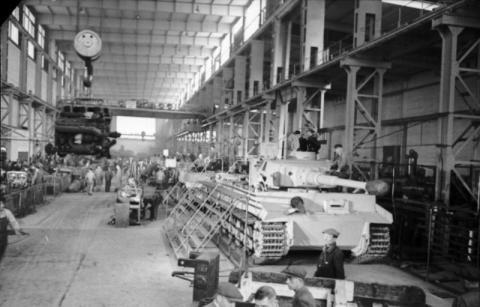
Krupp factory producing Tiger tanks
This puts the lie to Speer’s credo: “I put priority on the overall planning, not the construction of representative buildings; not so Hitler. His passion for monuments of eternity left him completely disinterested in traffic structures, apartment buildings and green space—social dimensions he neglected.” Already during his Landsberg jail time,8 Adolf Hitler was dealing with traffic questions and drawing designs of the Autobahn. Stimulated by his youthful experience in Vienna and Munich and by his study of city planning, especially Paris, his own ideas of city planning developed. They were powerful and modern. With his support of motorization, he put the German street system in order and, at the same time, dealt intensively with the parking problems.
He gave Dr.Todt the job to construct the Autobahn; he created the office of the Inspector General for the German Street System, a unique event in the history of German states. But aside from the individual traffic problems, he was aware of the great importance of the means of mass transportation—in the cities the subway, streetcar tracks, the U and S railway lines.
He saw the crowning solution for track-type railway traffic in the realization of a common European wide-track train system. He requested solutions of the rail-freight traffic known today as container transport. His interest in air technology and air transportation was unquestionable and known to everyone.
SPEER’S PRISON DIARY
“Speer told his interrogators that he had at least sixty different opportunities between January and February 1945 to commit high treason and even made plans, which naturally turned out to be technically impossible, to murder Hitler in his bunker. These were the stories that saved Speer’s head in 1946 and which he now proudly presents again,” writes Barraclough hatefully.9
In his Spandauer Tagebücher,10 Speer describes how the court psychiatrist, Dr. Gilbert, visits him in his cell after the pronouncement of the judgment, wanting to know how Speer accepts the decision. Speer answered, “Twenty years! Well, under the given circumstances they could not have given me a lighter sentence. I cannot complain. I will not complain.”
But one page later he quarrels with his fate. "Should I not have received a lighter penalty, since Schacht and Papen11 went free? I just told Gilbert the contrary. I envy them! Lies, cover ups and false statements did indeed pay off.” And with a reference to Hitler, he continues, “I did not help him into the saddle, I did not finance his rearmament. My dreams belonged only to buildings. I did not want power, I wanted to become another Schinkel.”12
Speer's design for a Führer Palace which Hitler said was not for him but for those who will follow him. Click to enlarge.
Almighty! This is not small stuff! Well, Speer writes a lot about Gilly and Schinkel, about the Dorian and Prussian style, but his designs for the staircase of the Office of the Reichsmarschall and for the facade of the ‘Fuehrerpalace’ contradict him. Still further on, he writes, “Why did I so stubbornly insist on my guilt. Sometimes I suspect it could have been vanity or boasting. I naturally know that personally I was guilty. But should I have acted that way at the trial? In our world, one survives better by maneuverability and slyness. Could Papen’s cunningness be a role model for me? If I envy him I also despise him. But I was 40 years old when I was arrested, I will be 61 when I leave the jail behind me.”
As far as flexibility, smartness and cunningness are concerned, Speer’s modesty is rather touching for someone who does not know him. In comparison, Papen was no match for him.
So he saved his head but he traded it for twenty merciless years in prison. Twenty years prison—I doubt I could have endured it. Speer certainly did not believe he would be kept that long, with the exception of the last years, because events happened during that time—the Berlin blockade and Korea—which gave him hope for an early release. Speer, no doubt, did not believe in the mischievous harshness of those who, with full intention and severity, insisted on persecution and execution and—God knows—still do it today. He reckoned with the success of the efforts of his daughter, Hilde, and the formal promise of support by Konrad Adenauer, Charles de Gaulle, Heinrich Luebke, Willy Brandt, Carlo Schmid, Herbert Wehner and Pastor Martin Niemoeller, the Lenin order bearer. He hoped! Even though he wrote in his diary in his 14th year: “…in the evening a hopeful report by Hilde. But these are her hopes, not mine." Well, they were his also.
Endnotes:
1) Nicolaus von Below, At Hitler’s Side, Greenhill, 2001, p 28. Original in German 1980.
2) Christa Schroeder, He Was My Chief, Frontline Books, 2009, p. 159. Original German edition 1985.
3) Maurice Utrillo was an untrained and prolific French painter who specialized in cityscapes of the Montmartre quarter of Paris. His popular scenes are often found on postcards.
4) An allusion to Speer’s preoccupation to be always on Hitler’s right side which is considered to be the preferential side.
5) The Pre-Raphaelite Brotherhood was a group of reform-minded English artists and critics who scorned the academic art of their day (1850’s).
6) A German historian, journalist, critic and editor who was a leading figure in the debate about the Nazi period.
7) Joachim Fest, Hitler, Berlin, Propyläen, 1973.
8) Hitler spent nine months in Landsberg Prison in Bavaria following what is called the “Beer Hall Putsch” in November 1923.
9) Geoffrey Barraclough, “Hitler’s Master-Builder,” The New York Review, 7-1-1971.
10) Albert Speer, Spandauer Tagebuecher (Spandau Diaries), Verlag-Ullstein, 1975.
11) Hjalmar Schacht, Reichsbank president 1933-1939 and Minister of Economics 1934-1937. Franz von Papen, Chancellor of Germany June 1-Nov. 17, 1932.
12) Karl Friedrich Schinkel, a Prussian architect, city planner and painter who died in 1841 is one of the most prominent architects of Germany, known for both neoclassical and neogothic buildings.
Tags
architectsCategory
Adolf Hitler, Art & Culture, Germany, National Socialism, World War IIBattle of the Architects, Part 3
- 23191 reads


Hermann Giesler on left; Albert Speer on right,
In this section of his book, Giesler gives his impressions and an architectural critique on Albert Speer's June 1971 interview in Playboy magazine. I have included it in its entirety, even the more technical parts that were, in a few places, difficult for me to decipher from the part of Wilhelm Kriessmann's original translation which never went through the editing process between the two of us before he died in December 2012. ~Carolyn Yeager
Speer in the "Playboy"
From Hermann Giesler’s memoir Ein Anderer Hitler
Speer im "Playboy", pages 318-329
1977 edition, Druffel-Verlag
Translated byWilhelm Kriessmann and Carolyn Yeager
copyright Carolyn Yeager 2014
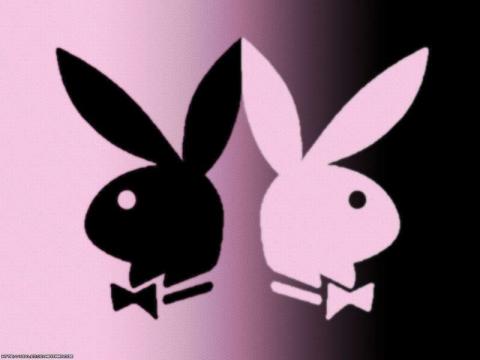
In the Summer 1971 my son brought me from America a peculiar magazine: Playboy, June 1971, the great interview “Albert Speer—Hitler’s closest confidant and second in command.”1 That interview in the sensationally edited magazine is accompanied by ill-reputed and illustrated jokes and by naked, boasting 'girls'. The answers given by the great ethicist and titan of repentance to the smartly questioning reporter, Eric Norden, in the multimillion-read magazine, are unique and way-out, and contain such wicked passages that they become unbelievable even at dimensions preferred by Speer.
The question arises : Did Speer really say that? As it seems, yes, because he did not distance himself from that Playboy-Norden interview.2
To my knowledge that interview has not yet been published in Germany. That’s why I will deal with some of the serious sections so I can point out the position of the converted Speer and his partly cynical tendency.
At first the magazine explains why they did the interview:
In order to find out the beginning and the scope of the Speer-legend and to investigate Speer's complications, his inner contradictions and character, the Playboy sent Eric Norden to interview the 66 year old ex-minister at his friendly wood house upon the hill, 3 miles from the university city of Heidelberg.
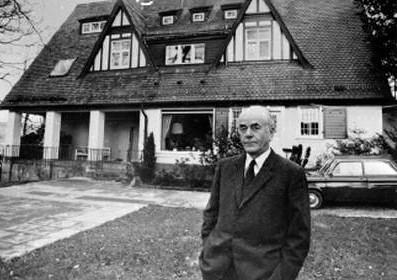
Norden writes:
Speer greeted me friendly and took me into the well furnished living room of his spacious house.
He still looks impressively like a distinguished manager. His bushy black eyebrows remind me of a younger man I saw in photos as he walked with his friend and patron Adolf Hitler through occupied Paris.
When we sat at the crackling fireplace sipping scotch and soda, snow began lightly falling outside and his 3-year old Saint Bernard, Bello, snored happily at the feet of his housemistress, who served us home made cookies and nourishing German tarts from heaped plates.
The atmosphere was so relaxed and gemuetlich that I forgot for a moment I was speaking to the man who, during world war II, stood beside Hitler in the second place of the Third Reich, the man whose organizing talents and energies contributed immensely to the death and suffering of millions. He appeared to me like some German of the upper middle-class, happy to have escaped his working office and now enjoying playing the role of a country squire.
For six weeks I studied that man, brooded over his book, the published interviews, as well as the numerous reviews and polemic articles by the American and European press. But when I bent over to turn on the recording set, I did not feel myself closer to the real man behind the well-known façade than before. During my research work about Speer I became frustrated by a certain non-existant transparency. And when we began talking I had the same doubts I faced during the time I read his book, and studied his public explanations. As sincere as he appeared to me on the surface, it seemed to me as if a veil was drawn between him and the truth.
I guessed, as also some of the reviewers did, that the litany of his self-accusations reflected an evading of final responsibility. Now, when I began the interview which stretched over nearly 10 days, with relentless question and answer sessions and which ended taking Speer as well as I to the edge of exhaustion, all that uncertainty remained, enforced by his strange attitude of indifference.
When my questions were asked till deep into the night and continued next day at breakfast, I recognized what bothered me most was his quietness, the way he accused himself of the most terrible crimes and with the same level voice offered me a piece of apple pie.
But when I listened to Speer describing terror and triumph of the Third Reich in German and fluent English. which he learned in Spandau, when I noticed during our tiring meetings how he tried with patient interest to tell and explain his doing at that time--I recognized this interview and all his other confrontations with the press and the public expresses part of the burden he is carrying, part of his repentance, stations on the road to his redemption he considered cannot be accomplished.”
Then the interviewer begins with questions. They offer Speer the opportunity to spread out for millions of new American readers his doubtful mea culpa, his dramatic repentant confession, his distortions and, as Norden writes, “the litany of his self accusations.”
This is not my cup of tea. I am interested in questions and answers I can judge, about Adolf Hitler's city-building and architectural planning, the discussion of Norden-Speer about the renewal of Berlin. My sons translated for me and were reading :
“All that moved me in those days,” Speer said, “was my ambition to excel as Hitler's architect.”
Your ambition seemed to grow in proportion to the crimes committed by your benefactors, Norden suggested.
“Yes I assume so,” Speer answered and continued, “I think Hitler planned from the beginning on to engage me with a task he was dreaming to fulfill since his youth.”
Now Norden asked him when Hitler first talked to him about those plans.
“He called me in September 1936 and unexpectedly gave me the biggest job of my career: together we would rebuild Berlin as the dignified capital of the Third Reich. The plans for his new Berlin were indeed astounding and its execution, I was sure, could turn me into one of the famous architects of history. Hitler imaged a gigantic new capital renamed Germania, at the same time seat of his Reich and the monument to keep the memory about him forever alive. The city's core would be flattened and be replaced by a 3-mile long boulevard called the “Prachtstrasse” (Splendor street).”
I interrupted and said:
Speer’s description is completely distorted and also factually incorrect. Look at the photo of the over-all model of the Berlin renovation. Speer published it in his Erinnerungen (Memoirs), wavering between pride and played sarcasm. Look and understand what Hitler aimed at. No way a new gigantic Reichscapital, but rather to introduce new building ideas and give Berlin's shapeless center a new image and order. He picks up a architectural idea of the early 19th century: Schinkel planned at that time to complement the only representative East-West street system, the Great Kurfuerst's “Unter den Linden” with a North-South opening, to offer an expansion to the capital.
It is not like Speer said, that the heart of the city would have been leveled. The open space for that urban renewal would have been gained primarily by eliminating the large railway system … Read further ahead and you will recognize this tendency of Speer's.
“The splendid avenue, twice as wide and three times as long as the Champs Elysee, stretched from the Brandenburg Gate to the decisive center point of the whole complex, the Cupola-hall…” Enlarge
Hold on, I interrupted, that’s not correct, but maybe the interviewer Norden caused some confusion. Not from the Brandenburger Gate should the “splendid avenue” stretch itself out, but from the planned South station towards the North to the square in front of the Reichstag. It was passing by the Brandenburg Gate at its West side. As a large traffic axis it should begin at the Autobahn circle, cross the East-West axis and connect with the Autobahn circle at the North.
And the comparison with the Champs Elysee is purely arbitrary. Already today the connecting Avenue Foch, conceived during the regimes of horse carriages, was twice as wide as the Champs Elysee.
My sons translated further:
“… the decisive center point of the whole complex, the Cupola hall, a gigantic arched meeting hall, four times as big as the capitol building in Washington DC. with a capacity of 180.000 people.” Enlarge
Well, well, I said, if he figures four persons per square meter without reductions for entrance he might just come out right. I know his Cupola and its dimensions. But continue with the story:
“On the way to the meeting hall, a gigantic triumphal arch would be erected, 400 feet (120 meter), dwarfing the Paris Arc de Triomphe, surrounded by a gigantic stadium for 400.000 people...” Enlarge
Objection. Speer was certainly misunderstood here; Playboy mistook the locale. That giant stadium was supposed to be built at Nuremberg, or did Speer build it once more in Berlin? The size scale originated with Speer, who brags to have surpassed Adolf Hitler's scales, which he now calls megalomania. Yet, the Roman circus maximus at the foot of the Palatin had, according to Gregorious, a capacity of 385,000 people. Lets continue:
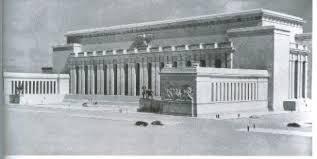
“A massive soldiers-hall which would house the OKW (Oberkommando der Wehrmacht) …
Nonsense, those were two different building-groups.
“new headquarters for the Ministry of Foreign Affairs, the Party, the Luftwaffe and a new parliament building for his Yea-saying Reichstag ..”
What a confusing description—and yet Speer forgot the building for Goering with the column salad, the Reichsmarschall's staircase-house. Here, look at it!
I pointed to the photo of the model of that staircase house in Speer's Erinnerungen. I can still hear Adolf Hitler's voice when he said the Reichstag building should be preserved. It's there in the overall model, clearly visible.
Speer then described the projected “mighty (Cyclopean)) fortified “Fuehrerpalace.” I asked for a repeat reading, it sounded so unbelievable.
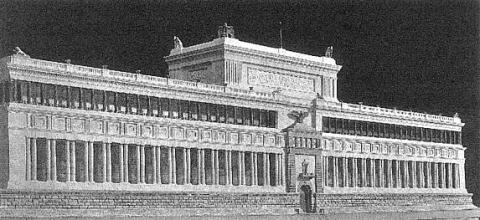
“A Führer Palace with 22,000,000 square feet base area, with wide receiving halls, extended gardens and a dining room for several thousand people.”
There is no doubt about the untruth of the measurements of that area; also no mistake of converting the square foot to square meter as I originally thought because Speer topped that strange statement by the following comparison:
“Beside Hitler's (it was Speer's, not Hitler's) projected palace complex, even the biggest building structure of its kind in history, Nero's famous “Golden House” with its 11,000,000 square foot area, would have shrunk to a mere insignificance.” Enlarge
No, I said to my sons, this is not an error or a mis-hearing by the Playboy interviewer Norden, but a silly, manipulating description by Speer. He presents here a whopping untruth which a blind man can touch with his cane—which I would say any architect can measure with his measuring stick. With such nonsense, Speer apparently wanted to demonstrate to the unwary American reader a despicable Hitler.
I took a ruler and we started to calculate. According to Speer's own planning I arrived at 22,000,000 square feet—approximately 2 million square meters—still 254,600 square meter are a rather big footage for the whole building area. And the actual area would have amounted to 106,000 square meters, including the “dining room for several thousand people” and also the office tracts for the Reichs-Presidential-and-Fuehrer offices. It really is the reverse of Speer's description.
Beside Nero's Golden House, the “Fuehrer Palace Complex” would have “shrunk to the insignificance” of about a quarter of Nero's scale even by Speer's own megalomania. Such surface area confusion and measurement distortions by Speer can be clarified by a look at the respective literature:
“Nero's 'Golden House' had 1 kilometer at its square (one million square meter, 11 million square ft). A single lake of that vast area could later become the construction ground for the Colosseum. The audience hall of the Flavian state palace at the Palatin was quite wider than St. Peter's cathedral. Inside the Tepidarium of the Diocletian thermal springs, Michelangelo could build the splendid church of St. Mary degli Angeli—ruined later on by Vanvitelli—and the giant roundel of Rome's railway station is nothing else but the exedra of the same thermal springs. Similar comparison can be seen between the piazza Navona and Domitian's Circus Agonalis. By its challenging high spirits (Uebermut), yes, by the hubris of its dimensions and the natural perfection of its creation it announces a true elation for what men can do on their own and, by its hardy optimism, in spite of its late creation, still very much with the heart of the antique paganism." (A quotation of Fritz Alexander Kauffmann, Rome's eternal face, Murnau 1940)
I added to it: When I looked at the gigantic Roman structures, may they be the Coloseum, the thermal springs, Konstantin's basilica or Hadrian's sepulcher, it never occurred to me that they express a hubris in their dimensions. I recognized them as the extent of the Roman power of expression. And if you interpret that hubris as a “sinful high spirit” then I myself will convincingly and frankly agree with it.
The reformed (changed) Speer, I continued, does not, however, admit it as he now explains. He does not have the heart to feel the high spirit of that 'paganism.' Otherwise he would today not cloud the harmony which we could have experienced with scorn and derision. And I again hear Adolf Hitler’s voice when he said: 'Not for me, I do not need that—for my successor.' In the size and at the same time in the limit, which I think is right. And that limit can be seen in the over-all view of the model which does not correspond with Speer's design on the following page of his Erinnerungen. His description in the interview and in his memoir does not comply with the model.
We continued reading the Playboy :
“Hitler believed that after centuries had past, his gigantic assembly hall would obtain a great venerable significance, and become a holy shrine for National-Socialism like St. Peter's Cathedral was for Roman Catholicism. Such a cult was the basis of the whole plan. He imagined his new capital as an eternal alter of his greatness, to immortalize his political credo (Weltanschaung). By using stone he was planning to make sure to gain immortality like the old pharaohs. Germania would become a sarcophagus and not a city.”
And again I had to interrupt the epic flow of the interview, not because of Speer, but to point again to the pictured model of the Berlin design: What a sovereign and convincing creation of city building based on Adolf Hitler's ideas! The arrangement of the North-South axis is unique. All proportions and scales of the square and street spaces, and the buildings themselves, judged by city building standards could not have been better. The intervals between the vertical and horizontal buildings are tightened and full of tension, the crowning finish is the all dominating cupola hall giving the central space that which had been aspired to for centuries.
The possible critique on details is of secondary importance compared to the magnificent overall concept that does justice to the multi-million-occupant city without reaching, let alone exceeding, scales set up by the Great Kurfuerst already built in the 17th century for the ten (and later forty) thousand-inhabited city. The 60-meter-wide avenue “Unter Den Linden,” its development and the large-dimensioned castle by Schlueter, were, by the same standards, “megalomaniac” compared to the small-scaled village-type buildings of the time.
Berlin Cathedral in the foreground to the Brandenburg Gate in the far distance, with the tree-lined Unter den Linden in between ... almost not large or grand enough today. Enlarge.
This fascinating city renewal task was given by Adolf Hitler and it was up to the responsible architects if and how they handled that order—if they would do justice to that task. Contrary to his ideas at that time, Speer sees it now that, by his effort, Germania would not have become a city but a sarcophagus!
I don't agree with that either and I repeat: The superior idea of building a traffic-friendly city renewal dominates; the rhythmical order of the masses of buildings convinces and is permanent. If some details give reason for criticism, it could not destroy the overall concept of a city renewal. It is strange that I, his “opposite-player in Munich,” am called on to protect Speer's earlier assumptions of Adolf Hitler's rebuilding plans against the current “Mr. Reeps.”
That the Führer Palace should outdo Nero's famous “Golden House” by two times corresponds with Speer's gigantism and not with Adolf Hitler's demand. Adolf Hitler's needs for housing and representation were well-known to me because he wanted me to design his private home, first in Munich and then in Linz. His personal requirements were moderate, even modest. They were, however, different when he had representative buildings for the nation in mind, among them also the Führer-palace because “my successors will need it.”
Giesler recalls Hitler in Paris
And then follows again a cut back: At the nightly talks with me at the various headquarters until 1945 he always pointed out the necessity to check very carefully many of the building plans in order to arrive at a clear gesticulation (Gebaerde) of the architecture. He insisted on a modern tectonic justifying the use of steel and steel-concrete. Severe simplicity should be striven for to comply, with dignity, to the sacrifices of the war. Those thoughtful demands of Adolf Hitler corresponded with my own principles in my work as his architect.
The triumphal arch and the cupola hall were based on Adolf Hitler's design sketches and scale notes from 1925. He talked to me several times about the size relations of those buildings, as in Winniza remembering the ride thru Paris at the end of June 1940, impressed then by the Champs Elysees, the Etoile and the Arc de Triomphe.
At that time, Adolf Hitler recapitulated:
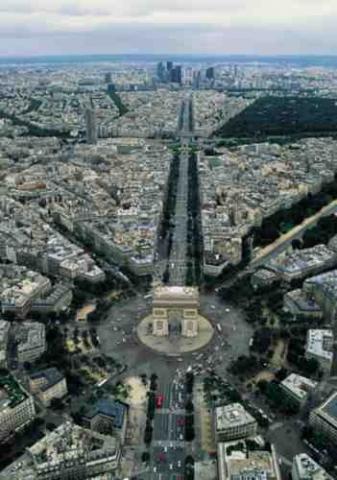
"Thru the haze of an early summer morning we drove from the large Place de la Concorde along the Champs de Elysees. The view towards the Arc de Triomphe was uniformly integrated by the greened tree rows of the street, but even by that street-space-limiting way the Triumphal Arch (at right) seemed to be too small. Certainly so when in winter the leafless trees opened the view all the way up to the buildings along the street. The Etoile is for our present motorized epoch too small to be useful as the final traffic square for dispersing 12 boulevards and streets; it will be split up and displaced. But then again the Etoile could not be made larger by adding the tree growing gardens of the neighborhood, for the harmonious scale of the Arc de Triomphe will be affected.
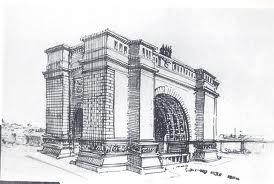
"In Berlin, the Triumphal Arch will arch across a street cross, its dimensions and cubic masses will concur with the proportions of the square and wide street spaces. Yet I see the Great Arch always as the primary manifestation of our idea to build a monument for the soldiers who gave their life fighting for Germany, and the symbol for all the struggles for our nation and her existence. Feeling this way, I sketched this arch at that time [in 1925, above] with the Gloria (glorification Sieges/Ruhm Goettin) inside, under the high, massive, heavy domed ceiling. That Gloria fulfilled a dual purpose: as contrast to the mass as well as disclosing the scale."
The cupola hall [the Great Hall] with her diameter of 250 meters expresses the powerful strength of the Party, but also a proof of what 20th century technology can do.
For a superintendent [a Protestant clerical title], it would naturally be too large. The idea what kind of a church by which the Protestant religion should be represented is demonstrated by the numbered seats at the Berlin cathedral. [A cynical comment referring to the poverty of spirit of the Protestants. -cy]
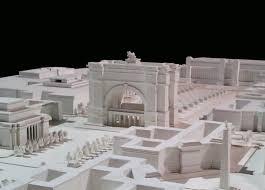
When Speer was working on the detailing of the model for the triumphal Great Arch (he presented it to Hitler on his 50th birthday,1939), he kept to the sketches by Adolf Hitler of 1925. [see at right] But as I explained, he departed completely from Hitler's original drawing when working on the plans for the “Great Hall,” the cupola hall, including on the model, which was very detrimental to the whole idea of that structure.
Hitler's drawing
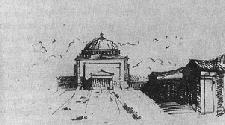
What I explained to my sons can be easily checked. Hitler's drawing of the gigantic hall reflects calmness and dignity. The quadratic, monolithic colossus is basically drawn along the scales of the Golden Mean (Goldene Schnitt) and carries the flat cupola effortlessly. The generously graded tambour/drum rises clearly out of the stone colossus and lets the cupola float. Even on the sketches you can feel by the shape of the cupola and the wingspan of the ribs, the material: steel. That gives the giant the scales and technology of the 20th century.
Even the portico of the entrance hall does not disturb the unity of the edifice by its over dimension of the scales of the classical order. That portico certainly reflects a reminiscence of the entrance hall of the Roman Pantheon.
The structure of “The Great Hall” is very familiar; one thinks about Gilly and Schinkel. It might well be a giant, but not a stranger in Berlin.
Speer's design
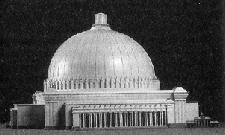
It's different with Speer. The stone-cube is flattened and has to be supported by pillar-towers. The broadly set dissolve of the wall area by the entrance hall seems to weaken the foundation. The tambour moves away quite a bit from the supporting stone structure, an addition of the cupola whose parabolic ascending curve denies the steel construction: the cupola does not float anymore, it weighs. Eighteen segments of the cupola appear before your eyes—by that tight setup they turn into scaled segments of a stone vault wrapped into metal, a giant forest of green patinated copper. If you take an overall view, then only nine out of the numerous segments would conform with the technological-static spans of a steel construction, as it was suppose to be done.
The tambour—Michelangelo's vivid one at St. Peter's or the calm one at the Florentine cathedral—swings away from the cupola. That tambour degenerates in Speer's model to a powerless affectedness.
Speer took away the giant's uniqueness and dignity by petty scales. Etienne Boullee of the 18th century, Friedrich Gilly or Friedrich Schinkel of the 19th, would have mastered the idea of structures with the technology of our time.
Back to the Playboy interview. To the question: Do you have any lingering regret that those plans have never been completed, Speer answered:
“I have to admit that regardless of its absurdity and madness I still find it difficult to free myself completely from the power those plans had on me for so many years. Understandingly, I can now despise them; but deeper inside myself they still have a hold on me. Maybe that is one reason, beside others, that I hate Hitler so deeply. He not only enabled me to destroy my conscience but consumed and perverted the creative energies of my youth.”
However, Speer is not yet at the end of his answer to the Playboy question. He further says:
“But because those plans still create an inner fascination for me, I am glad that they have never been completed. I can see now, what I could not see then, that they were, at their conception, immoral. The proportions were alien, inhuman, reflecting the frigidity and inhumanity of the Nazi system. 'I build for eternity,' Hitler used to say to me, and that was true. But he never built for people The size and scales of his monuments were a prophetic symbol of his idea of ruling the world. And the gigantic metropolis he imagined could only serve as the heart of a conquered and enslaved empire. One day in summer 1939, when we stood in front of the wooden models and Hitler pointed to the gold German eagle with the swastika in his claws, a crown at the top of the cupola hall: 'That has to be changed,' he said with emphasis. According to his orders, I changed the design so that the eagle was now holding a globe in his claws. Two month later World War II broke out.”
I interrupted the translation once more: “That Adolf Hitler had a Germanic Empire within a United Europe in mind, one can not deny, nor condemn. Without doubt Germany, or the planned Germanic Empire, would have been a world power. But that Adolf Hitler planned to rule the world, or a world empire, that is not only nonsense, it is a misinterpretation, a speer-lish rubbish.”
When Speer mentioned that the eagle at the top of the “Great Hall” signified world rulership, that is as if the provincial president in Duesseldorf claims world rulership because his office is crowned by an eagle who holds a globe in his claws. Especially suspicious and dangerous is the fact that recently the eagle and the globe were again put on the building and gold-plated. That the lantern of the Berlin cupola ends at a globe with an eagle spreading his wings is a sculpture, commonly used. It had to end that way—very evident for any architect, not however for Speer.
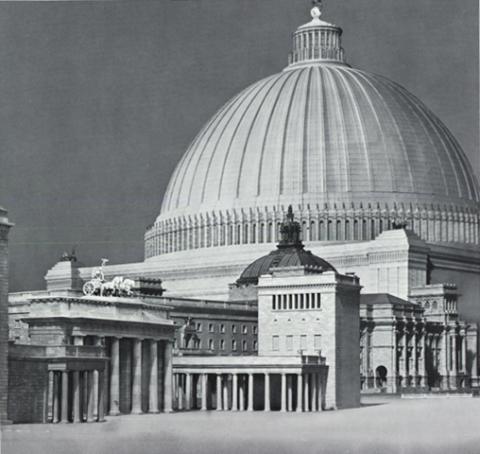
In order to characterize Speer's tendentious efforts, I opened one of the pages of his book Erinnerungen showing a photo of the model of the “Great Hall.” The gigantic cupola hovers like a gruesome nightmare over the Brandenburg Gate and the Reichs Parliament building. [Photo above] Terrifyingly, it takes your breath away until you orient yourself by the following page of the book and recognize how far apart and by what spaces in between the individual building groups are from the “Great Hall.” The model photos on the two pages of the book shows everything as piled into each other and above each other. “How strange those perspectives shift” Speer writes on another occasion, but it fits with the above.
The deficiency of photo technology offers itself for such picturesque distortions—no wonder that the Zugspitze [Germanys highest mountain] was also adopted to that panopticon in order to shrink when compared to the size of the parabolic cupola!
Speer zealously condemns his planning of Berlin and means that everything was not only crazy, but also boring, lifeless and regulated. But where his own gigantism breaks through—in none of his statements can he hide that—he turns it into Hitler-megalomania whose influence he could not escape, regardless of its absurdity. What Speer has to offer is a macabre mix of personal disappointment and a “know better” arrogance, ending with a self portrait where he again and again points out his mea culpa of a moral integrity.
The question arises—what kind of a split personality appears here, putting himself on a pedestal of an ethical principle and then vulgarly triumphing to say: Finally I could pay him back. Yes, he wants to defame Adolf Hitler. But he does not describe the man, he moves in the shadow that man casts.
Two significant responses I quote from the Playboy interview:
Question : Were there many inside fights in Hitler's entourage?
“Hitler's circle was like a Byzantine court, seeding with intrigues, jealousy and betrayal. The Third Reich was less a monolithic state than a net of opposing bureaucracies fighting each other and Hitler's satraps stacking their own, independent spheres of interest, expanding it scrupulously—often damaging the national interest.”
Quite a bit of that refers to Speer himself, he was masterly in his ablity to stack and expand his spheres of interest!
Question: Were Hitler's courtiers as corrupt as they were ambitious?
“Most of them would have let your American chap Al Capone look like a philanthropist.
From the moment they took over the power and had their hands on the state's treasury, they filled their own pockets, piled personal riches, profited from government business, built large palaces and country villas with public money, allowed themselves an extravagant lifestyle more fitting the Borgias than so-called revolutionaries. Rot penetrated everything; like a fish the Nazi government rotted from the head down.”
When that was translated for me I had enough and thought: The decent things at that Playboy magazine are the ill-reputed jokes and the naked girls. I looked at my sons who watched me during the reading and the lecturing, partly amused, partly worried. I leafed back to the first page of the interview and pointed to the three photos of Speer used as a subliminal subtitle for the introduction—the facial expressions selected to correspond with his statements—and I said, “Look, what a man! No, what a Saeulenheiliger!”3
Endnotes:
1. How many of Hiter's associates have been called his "second in command:" Rudolf Hess, Martin Bormann, Heinrich Himmler, and now Albert Speer. In truth, none of them were.
2. Speer told David Irving that he was misquoted. He claimed that Playboy magazine had grossly distorted the interview with him. He was not shown the English text before it was published, and the interview was conducted in German as his own English was not up to that standard. Irving wrote:
We discussed initially the book by Professor Hermann Giesler, Ein Anderer Hitler. Speer was negative about it. The book contained two completely wrong statements about him. There is, he says, an entire chapter attacking him. One wrong allegation is the suggestion that the BBC flew him to London under a false name, Reeps. The other point I cannot remember. However he agrees that Giesler's descriptions of the Landsberger Haftzeit (Landsberg prison time) and other Hitler matters may possibly be correct. I laughed at the way that the rival architects versteiften sich in solchen Kleinigkeiten (stiffen over such trifles).
But Speer is also quoted as saying that he is in basic agreement with everything in the interview.
3. A stylite, or pillar-saint is a type of Christian ascetic in the early days of the Byzantine Empire who lived on pillars preaching, fasting and praying.
Tags
architectsCategory
Adolf Hitler, Art & Culture, Germany, National SocialismBattle of the Architects, Part 4
- 6729 reads


Hermann Giesler on left; Albert Speer on right,
The following is something of a masterpiece of satiric wit from Giesler. -cy
The Column Saint
From Hermann Giesler’s memoir Ein Anderer Hitler
Der Säulenheilige, pages 355-360
1977 edition, Druffel-Verlag
Translated byWilhelm Kriessmann and Carolyn Yeager
copyright Carolyn Yeager 2014
 In the year 113 the Roman senate erected a gigantic column for the emperor and military leader Trajan. (Shown right) On the capital of the column stood the gilded statue of the honored.
In the year 113 the Roman senate erected a gigantic column for the emperor and military leader Trajan. (Shown right) On the capital of the column stood the gilded statue of the honored.
The art historian Bruhns writes ”Used to gigantism and always striving to exceed, Rome created that form of eternal triumph which then did mankind not less convince of its greater impression than the older kind of triumphal arch, now of a lesser rank. As the colossal column expresses the idea of “height” exceptionally well, it can also be used very well for the adoration of the “highest.” Antoninus Pius and Marcus Aurelius were given similar columns in Rome. Arcadius got his at the new capital Constantinople.
When Europe during the Napoleon era felt itself specially close to Rome’s greatness, it presented the new emperor with the Vendome column in Paris—and his conqueror, Alexander of Russia, a second one in Petersburg.”
The emerging Christianity overthrew the images of antique greatness and now paid homage to its believers on imposing columns. After the final decline of the ancient dignities around the 4th and 5th centuries, ascetic Christians requested the top of the Roman columns as pleasing to God. The best known among them was Symion Stylites from Aleppo. Those ascetics and penitents, called stylites or “Säulenheilige (column saints), strove to increase their ranking by self-elevation.
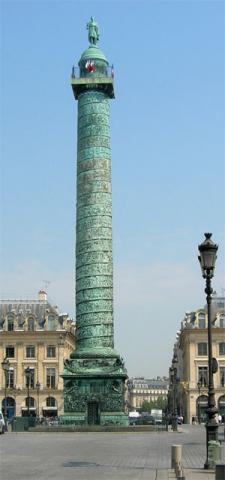
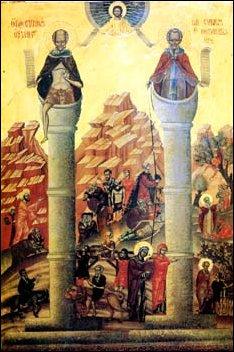
Napoleon 1 Column in Place Vendome, Paris, above left, and on the right an icon honoring Symion Stylites and "Symion the Younger" on their column homes where they remained for decades without coming down.
To enhance oneself—who wanted to hinder the column saint, standing between earth and heaven? Was he not predestined, by his high location from where he could overlook everything, to judge the bad, and if it had to also be mentioned, the good? Everything that came down from isolated but triumphant height was important, even scolds and abuses, if quite a bit drew attention only post festum (too late).
In Speer's Spandauer Tagebuecher I saw some caricatures sketched by his colleague Hans Stephan [on p494]. They were done during the high time of planning Berlin's renewal. Speer commented: “We treated our own gigantism ironically.”
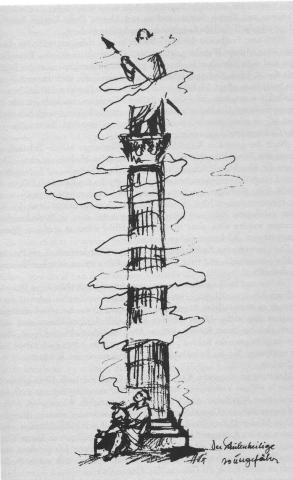 Now I remembered Stephan's ironic caricature. [Shown at left from page 357 of Ein Anderer Hitler] At first it seemed to have a double meaning but looking closer it was pretty obvious: One giant column pushes through layers of myrrh and incense, or even through clouds, up to an extreme height. Sacrificial smoke also shrouds the statue, clad in a Roman toga and holding a spear, characterizing the “most enhanced.”
Now I remembered Stephan's ironic caricature. [Shown at left from page 357 of Ein Anderer Hitler] At first it seemed to have a double meaning but looking closer it was pretty obvious: One giant column pushes through layers of myrrh and incense, or even through clouds, up to an extreme height. Sacrificial smoke also shrouds the statue, clad in a Roman toga and holding a spear, characterizing the “most enhanced.”
At first one would consider it as an antique Caesarean honor. But on the three step base of the column sits the chronicler dressed in a capuchin robe, busy and carefully making notes about all thoughts of the “most-enhanced,” of all his confessions and opinions but also his scolds, to make it known to the interested present and future generations.
The caricature referred to that time, but with the monk on the bottom of the column it was, as it has turned out, also pointed to the future. Stephan had portrayed as well the imperatorial present, as he pointed with a fine vision to “what is to come.” The monk on the column base does not allow any other interpretation. Did it ever dawn on Stephan how significant his depiction would become: Speer as a column Saint?
Yet, after all, he put him a few column-drums higher than the ascetic and scolder Symion Stylites from Aleppo. Because, as an architect, Stephan had a good feeling for rank and file.
After the publication of Speer's books I met quite a few who thought his strange change, his schizophrenic fantasies, his distortions and his obsession for abuse—plus his awkward readiness for remorse—were the result of 20 years of “jail-torture by isolation” as they used to call it, according to Sartre. I opposed that. There was too much influence from the world around him. It might be that the imprisonment aggravated the contours. Speer's “turnaround” is mere opportunism, cold and carefully planned, as it is in conformity with his genetically generated character—demonstrated already before his jail time.
Nuremberg, Prison and Beyond
After the grotesque comedy of the Nuremberg trials, when Speer tried to tie the bear Tabun (nerve gas but also the name of a Teddy bear -wlk) to the court-benches: “I had the intention to kill Hitler by poisonous gas however...” He was addressed by Kranzbuehler, the attorney of Grossadmiral Doenitz, who asked Speer if it would not have been more certain and more effective to shoot Hitler than start a poison gas operation endangering an unknown number of secretaries, drivers and others, without being sure to even get Hitler himself. Speer answered: “I could not shoot.”
The attorney's remark since: “That was enough for me to characterise his personality, and both his books only convinced me more.”
The experiences and statements of this former fleet lawyer need a further explanation: Had he known Stephan’s caricature, he would have reached another opinion, for from a column saint you do not expect that he knows how to shoot! Poison, however, you could imagine with a stylite. But again, not with Speer, the “second most important in the Reich”—he was only short of a ladder to execute the planned deed at the air shaft of the command bunker at the federal chancellery.1
In the “innermost circle” of the Speer boys they might have whispered about passionate plans while completely ignoring the real situation. Only in that way can I explain the phone-call of his colleague to the “central planning department” from cage to cage, in the prison winter of 1946: Nothing will happen to Speer—he will be the German minister for reconstruction! His willing guilty confession, combined with his assassination-attempt-declaration, would no doubt form Speer's basic defense. But it was only the first propaganda-cry of the first re-educator sent by the Americans to the German people. It became a success also of the crook “Dr.Gaston Oulman.”2
Beginning with the desperate Charivari 3 of his statements at the military tribunal, Speer intensified, as a prisoner, his unscrupulous abuses by quotations and secret messages, and then, after 20 years, as a free man in his books and interviews, not sparing even the victims of the victors' justice.
In order to justify himself in facing his children, so that they would not be ashamed of him, and “to help once more” the German people4 by, as he believed, his sincere attitude, he thought he had to take away from the fallen of the war, the fighters for the freedom of Europe, the meaning of the deep sense of their sacrifice. For the surviving dependents it must certainly be comforting to hear from Speer that their men—sons and brothers—were sacrificed, that their women and children were bombed, for a wrong ideal and for “a total madness.” Thus Speer has, as he wrote, “served his own people the best way.”5
There is also the infamy of the Nuremberg tribunal. Speer formed a bond with the American chief prosecutor Jackson. If there was ever a doubt about that, Speer arrogantly confirmed it 30 years later: “When Jackson started with his cross-examination, he smiled friendly. Anyway,” Speer continued, “I would have cooperated with anybody who would have supported my line to let the Germans regain common sense.”6
In his Erinnerungen, his Spandauer Tagebücher and in his scolding interviews, he tries to manipulate history and events. He wants to be involved in the confusion of the German people even though he thus exposes himself to the suspicion of a lack of historical awareness and truthfulness.
Horse dung [Rossapfel, Ross=horse] found on his bed in the Spandau jail put him into a schizophrenic frenzy. Speer associated it with the Reichsapfel, the imperial insignia of power and dignity. Then the horse dung is brought into a connection with the eagle holding in his talons the world globe.7
He discovers the “deeply criminal character” in Hitlers face and he believes he has to assume that a part of Adolf Hitler's success was based on an audacity to pretend to be a great man.8 But enough of all that.
Who does not remember? Speer was at that time considered to be the confidant; he appeared to be the Johannes very close to Hitler's heart. Naturally it was Speer's smartness, his extraordinary organizational talent, the nonchalant way he put himself into the scene, his ambition and effort to gain recognition and power—indeed he felt himself already as the sage. Therefore it was no surprise that Stephan placed him for adoration on top of the High Column, decorated with the leaves of the Acanthus. Towards the end, however, doubts entered and Christian soldiers carried out the fall of “the enhanced.” After his conviction, a cruel road lay ahead of him for decades. To alter his reputation, he severely re-shaped himself as is so fitting to his character.
With will power and toughness he began that road and walked on it. One can assume without doubt that he believes in himself and his strange mission. He reached his goal anew by his own way and under peculiar signs. Thus he remains on a high column, completely changed as Baal Teschuwa, the son of repentance, as his friend the rabbi Geis calls him.9
He wrote his Erinnerungen as that man, praised by the American historian, Professor Eugene Davidson as “an historical testimony par exellence” and as an “absolutely priceless document.” It took the writer Zuckmayer's breath away when he read the Spandauer Tagebuecher.
Speer begins his Erinnerungen with an aphorism of the theologian Karl Barth. Yet it would have been more fitting to begin with the caricature by Stephan—one would then be prepared for the confessions of a reformed person, the opinions of a column saint.
Notes:
-
Speer testified at Nuremberg that his plan to kill Hitler by placing poison in an air vent into his private bunker failed only for lack of having a ladder high enough to reach the vent!
-
A Vienna-born Jewish jailbird with the name Walter Ullmann, who called himself Dr. Oulma and became a radio commentator at the Nuremberg trials, before being unmasked and causing a big scandal.
-
A ritual used by Europeans to chastise community members who did not conform with social expectations.
-
Speer, Erinnerungen, p594
-
Eberhard Wolfgang Möller, Albert Speer oder das achte Gebot; in: Klüter Blätter,21. 1970, p53
-
Welt am Sonntag of Oct. 31, 1976
-
Speer, Spandau Tagebücher, p247
-
Ibid, p52
-
Ein Mensch namens Albert Speer; Das Evangelische Darmstadt, Oct. 17, 1971
Tags
architectsCategory
European History, GermanyBattle of the Architects, Part 5
- 3714 reads


Hermann Giesler on left; Albert Speer on right,
THE DISCORD
Translated and condensed from Hermann Giesler's Ein Anderer Hitler by Wilhelm Kriessmann and Carolyn Yeager
This is a condensation of the 15-page section Der Zwist on pages 340-355
copyright 2014 Carolyn Yeager
“ Powerful and at the same time not interested in power” … so judges the American historian, Professor Eugene Davidson, about the author Adalbert Speer, when reviewing his book Erinnerungen.
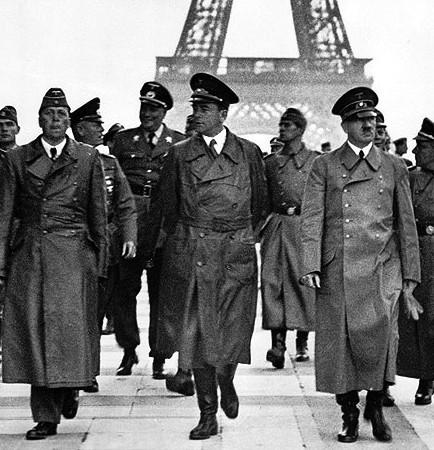
The following footnote (Chapt. 4, #32) from Joachim Fest’s Speer: The Final Verdict reveals the disdain Albert Speer felt toward Hermann Giesler that was probably the root of the problems between the two men.
“… in the caption to the picture showing Hitler in front of the Eiffel Tower, (Speer) mentions Breker but not Giesler on his right. […] In conversation Speer remarked that Giesler had been distinguished “beyond merit” by Hitler's invitation. Asked if he had been jealous of his rival, he replied, ‘How should I have been jealous of him? Giesler was a frightful petit-bourgeois! How could he supplant me in Hitler's favor?’ […] How unremitting Speer’s feelings were for Giesler emerges also from the fact that he consistently misspells his name with what seems like pointed indifference.”
Giesler chronicles his major dispute with Albert Speer as beginning in late autumn 1940 when he received from Hitler the task of designing the renewal of Linz, in addition to Munich. After that, Speer had asked Giesler if he would agree to his (Speer) taking “over-all control” of all city building work in Germany and with it over-all responsibility. “In the future I would like to be involved more than I am now with the Gaustaedte (cities in the party districts/provinces) where questions about city renewal might arise which are also connected with party buildings. I believe this is necessary in order to avoid wrong planning.”
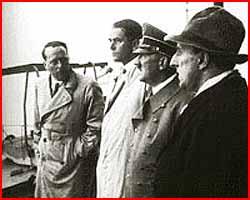
Another reason he put forth was that it would make it easier for the Führer to make decisions. Giesler, who saw himself and Speer as a team functioning cooperatively for the good of Germany, and being already overloaded with responsibility for the planning of Weimar and Augsburg, replied, “Naturally, I would agree.” (image: left to right, Giesler, Speer, Hitler, Roderich Fick in Linz on the Danube)
A few months later, Giesler received a letter from Speer in which the latter referred to the former's “joyous” agreement, and concluded, “Your approval was one of the most important requirements to take further steps.” Steps where, Giesler wondered?
Soon, it was obvious. Their casual agreement resulted in allocations for the Munich renewal (G's assignment)—primarily steel and iron—to be taken care of by Speer's Reich office of Generalbauinspektor (General building inspector) in Berlin. After work had begun on the federal railway system in Munich, all allocations stopped and every effort brought no results. “The reputation of the office under my leadership was at risk,” writes Giesler. He requested a meeting with Dr. Fritz Todt, at which it was made clear that all G's requests for allocations were entirely dependent on Speer and his allocations administration.
“But not only that, all deadlines for construction, dispositions and new planning projects were not able to be met by me. The complaints of the railway management for new projects and their construction piled up at the ministry and at my office work was partly stopped.”
Giesler again went to Dr. Fritz Todt and spoke frankly, but with no success. Speer was favoring his own projects.
It was the same with the supply of stone material—they were in the hands of Speer and were not sent to Giesler. On his own, he could get hold of only concrete and a limited supply of Tuscan travertine. At this point, Giesler recalled Adolf Hitler telling both him and Speer that if they had any problems with these important building assignments to go to Bormann and he would help them. This Giesler did, and Martin Bormann (below right) met with Dr. Todt and Speer and asked for a letter from Giesler explaining the situation at his building sites caused by poor allocations. In his letter, Giesler asked that Dr. Todt take over the administration and distribution of allocations.
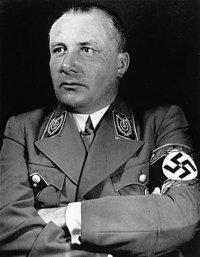
Once Bormann saw the scope of the problem, he sought to avoid a serious discord by asking Giesler to hold back. Toward the end of 1941, Speer drafted a Führer-Directive to forward to Hitler which gave him (Speer) absolute power of decision for all building projects in the Reich. Giesler says he knew such a directive would never be approved and thought that Speer also must have known that Adolf Hitler would not have considered a “central responsibility” and “central direction” proper for all these artistic creations, in a federally structured Reich with it's traditionally grown and regionally cultured Gaue. And, indeed, Speer withdrew it before it reached Hitler.
Now Speer went in the opposite direction. Bruised by his failed attempt at a total takeover, he decided he didn’t want any responsibility except for his own projects of Berlin and Nuremberg. On Jan. 20, 1942 [just so happens to be the day of the alleged Wannsee Conference -cy], Speer informed Reichsleiter Bormann that he was relinquishing all responsibility for [NSDAP] Party buildings which he had formerly held. That decision, Speer said, was caused by the negative opinion of his Fuehrer-Directive expressed by Professor Giesler. He further stated that he would now have free time at his disposal and asked the Führer to entrust him with the building of the new city of Drontheim [southwest of Trondheim in Norway].
Speer's unusual birthday present to the Führer
Amongst other shenanigans and intrigues, Speer also sought to undercut Giesler’s authority for the Linz city building project by bringing a birthday greeting to Hitler at midnight on April 20, 1941 in the form of an offering which read:
My Führer—On your 52nd birthday the undersigned artists of Berlin’s renewal beg you that they may participate at the noble competition for the new layout of the city Linz at the Danube.
It was signed by Speer and 15 of his Berlin team of architects, sculptors and painters. Giesler had already been designing, at Hitler’s request, the Linz plans and models for 6 months! Writes Giesler:
When I read this [in the Party Chronicle] after so many years I was perplexed. Was that really the reason Adolf Hitler made the remark at our meeting at the headquarter Winniza, 1942 , when he said : “in the future you select the architects you want to work with at Linz.” His entourage, who knew about that strange birthday, did they not wonder? I can understand that Bormann did not want to stir up the matter; he rather wanted to defuse the quarrel between Speer and me.
That's how it was at that time—Speer did not miss a minute to make the Führer happy. Or was it a limitless and offended ambition which encouraged him as manager, coach and player of his national team of architects, sculptors and painters, all bound to duty at Berlin, now to enter the field of the Linz renewal? Why really—to drive away the lonely one, entrusted by Adolf Hitler to plan his retirement seat at his hometown, by a “noble competition”? […] Anyway, to present that proposition as a birthday present—I consider this even today as tasteless.
Fritz Todt dies; Speer advances to Minister level
When on Feb. 8, 1942 Dr. Todt died in an airplane crash and Speer became the successor to his office, the two architects had a meeting and made a peace, as had been Todt’s wish, and also Bormann's directive. But it was a practical one, writes Giesler, and adds that it ended for him “with Speer’s statement at the IMT [International Military Tribunal] and again when he spoke Sept. 30, 1966, the day of his freedom.” The ‘friendship’ was finally buried amid “the pile of Speer’s silly distortions and proofs of his successful "re-education" by his statements, interviews and books.”
There are in front me notes about Speer's letter to Bormann Jan. 2, 1942, ending : “Therefore, my only New Years wish for you: to give the Führer by your responsible work in the year 1942 much joy and few disappointments. In friendship and dearest greetings, Heil Hitler! Your Albert Speer
And here is the Playboy interview with the question :
What kind of a man was Bormann?
Speer: “He was the roughest, most brutal and merciless member of the Nazi hierarchy—and believe me that means something. Personally, he was violent and primitive, without any culture or sensitivity. By nature he was a servile person but also a brute, treating his staff like animals with a sadistic contempt for their feelings. Either he crawled at their feet or went after their throat, a most evil type of a farmer with the most evil kind of a farmer’s slyness. He knew how to mislead people so that they believe him to be an unimportant, trustworthy helper of the Fuehrer, while all the time cunningly building his own empire.”
Quite different from this hateful image Speer was drawing of Bormann were his hackneyed phrases with which he finished his letters to Bormann: “And I beg you most sincerely to give me your friendly support” and “in friendship and with dearest greetings.”
Giesler ends with words he received a few years ago from a former colleague on the Weimar and Munich projects: “Mr. Giesler, you have to admit that Speer was far superior to you.” Giesler agrees:
Well, naturally he was, I said, and how!
and thinks about why that was so. Speer was both a mathematician and an architect—with a mathematician's controlled thinking. For the sake of control, he wanted supervision. He had everything at his disposal--a large office with excellent architects, city builders, engineers, landscape architects, sculptors and painters--and could delegate to others, giving him time and working strength to do that which he wanted to do himself.
I was only an architect. Speer was mighty … yet, at the same time, with no interest in power.
~END
